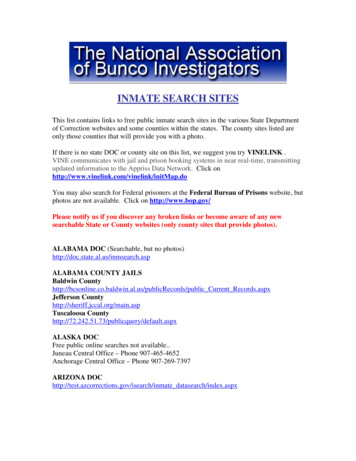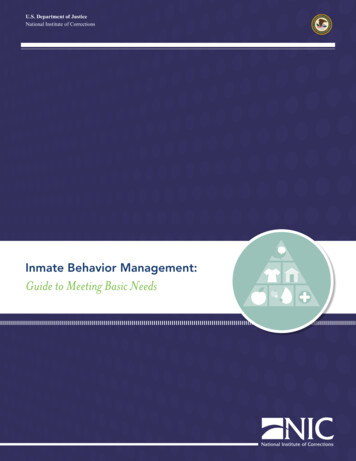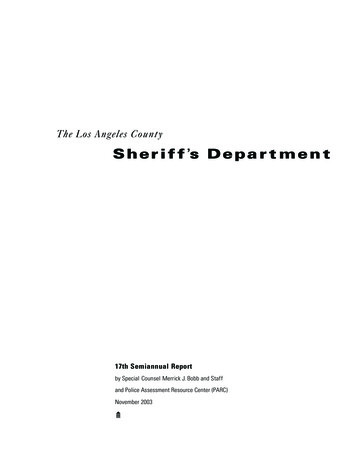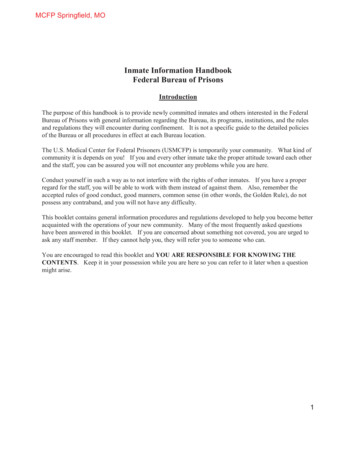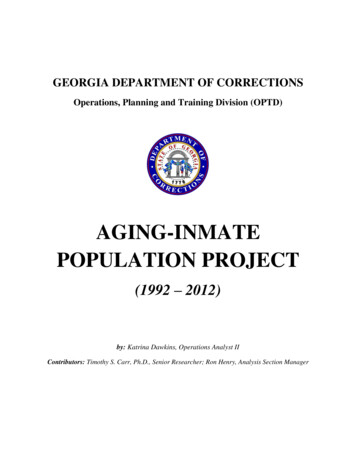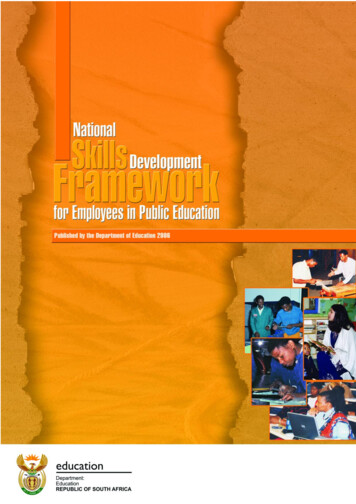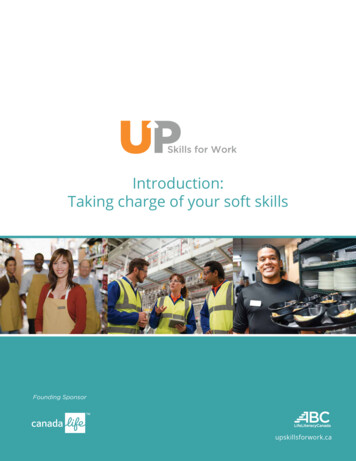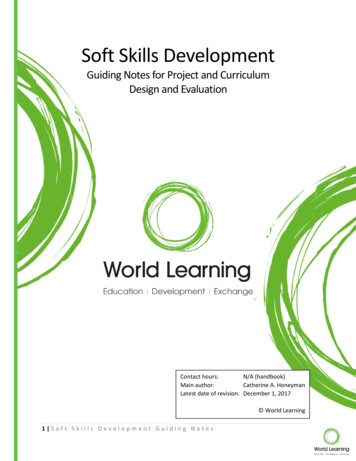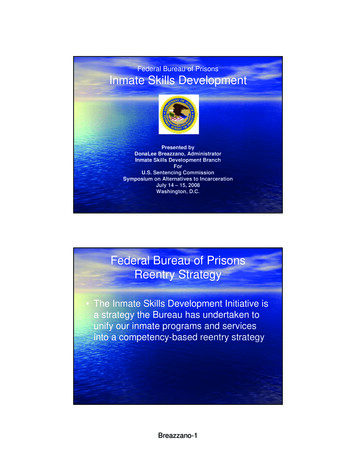
Transcription
Federal Bureau of PrisonsInmate Skills DevelopmentPresented byDonaLee Breazzano, AdministratorInmate Skills Development BranchForU.S. Sentencing CommissionSymposium on Alternatives to IncarcerationJuly 14 – 15, 2008Washington, D.C.Federal Bureau of PrisonsReentry Strategy The Inmate Skills Development Initiative isa strategy the Bureau has undertaken tounify our inmate programs and servicesinto a competency-based reentry strategyBreazzano-1
Inmate Skills Development InitiativePrimary Goal:ENHANCE EFFORTS TO EQUIPINMATES WITH THE NECESSARYSKILLS TO SUCCEED UPON RELEASETO THE COMMUNITYInmate Skills Development Initiative –Cultural Shift IT IS NOT A PROGRAM: IT IS:A shift in cultural philosophy (reemphasis of ourmission) to provide a holistic, collaborativeapproach between internal components andexternal agencies to ensure skill needs forsuccessful reentry are identified, addressed, andoperationalized.Breazzano-2
Federal Bureau of PrisonsMission StatementIt is the mission of the Federal Bureau of Prisons to protectsociety by confining offenders in the controlledenvironments of prisons and community-based facilities thatare safe, human, cost-efficient, and appropriately secure,and that provide work and other self-improvementopportunities to assist offenders in becoming lawabiding citizens.Traditional Program BenefitsasManagement Tools(Balancing Security and Reentry) Reduce rates of misconduct Motivate to participate in other programs Demonstrate appropriate interaction withstaff Yields a safer environmentBreazzano-3
History of Program SuccessSuccessful return to the community Residential Drug Abuse Program- 16% less likely to recidivate- 15% less likely to relapse Federal Prison Industries/UNICOR- 24% less likely to recidivate- 14% more likely to be employed- 23% reduction in misconduct Education Programs- 16% less likely to recidivate Vocational Training- 33% less likely to recidivateINMATE SKILLS DEVELOPMENTMultiMulti-Tiered ProcessDynamic assessment of nine skill areasGeneration of individualized Skill Development Planto monitor progressTargeted Program Linkage to address skill needsprioritizing high risk inmateCollaborative partnership building to assist withcommunity transition and resource developmentBreazzano-4
Reentry Skill SetsACADEMICIntellectual FunctioningLiteracyLanguageINTERPERSONALComputer Skills Family Background Family Ties / Support System Parental ResponsibilityVOCATIONAL / CAREER Relationshipsj Employment History Communicationsj Career Developmentj Institution Work Historyj PostPost-IncarcerationWELLNESSEmploymenth Health Promo/Disease Prevh Disease/Illness Managementh Transitional Planh Government AssistanceReentry Skill SetsMENTAL HEALTH Substance Abuse Management Mental Illness Management Transitional Plan Appropriate Sexual BehaviorCHARACTER Personal Character Personal ResponsibilityCOGNITIVEa General Behaviora Criminal Historya Domestic Violence/Abusea Criminal BehaviorLEISUREÓ Use of Leisure TimeDAILY LIVINGMoney ManagementFood ManagementPersonal ingRRC PlacementFamily Care Breazzano-5
MULTIMULTI-TIERED PROCESSASSESSMENT AND SKILL DEVELOPMENT PLANA tool used for the automation/integration of existing systems toto supportagency mission and policy requirements; assists with: Assessing skills (Inmate Skill Assessment) Tracking/coordination (Inmate Skills Development Plan/Program Linkage)Linkage) Reporting Targeting resource needs/ priorities (High Risk Offenders) Electronic exchange of information (data/reports) Streamlining tasks & forms (progress reports/case management/etc.)management/etc.)INMATE SKILLS DEVELOPMENTSYSTEM Initiated at the beginning of the inmate’ssentence and dynamically updatedthroughout incarceration to assess andmonitor skill development and resourcesneeded for reentry. The information (ISD Plan) is shared withagencies collaborating/assisting withtransitionBreazzano-6
PROFILE SECTIONASSESSMENT PLANBreazzano-7
PROGRESS AND GOALSBreazzano-8
Breazzano-9
INMATE SKILLS DEVELOPMENT SYSTEMReport Options QUESTION ROSTER/Statistics - roster or number/percentage ofinmates providing a selected answer to a selected question SKILLS ROSTER - roster of inmates for selected skill sub-area andcolor INSTITUTION STATUS - report of percentage of inmates foreach skill area and status that meet a selected percentage(threshold) INMATE STATUS COMPARISON - status reports for selectedtime periods to compare inmates progress in skill developmentNational Offender WorkforceDevelopment Partnership(Program Linkage/Partnership & Resource Development)Goal:To establish collaborative strategiesand joint programs that supportthe development of careeropportunities and enhance thecareer-readiness of offenders tosuccessfully transition to theircommunitiesBreazzano-10
www.nicic.org/NOWDPDefendant/Offender WorkforceDevelopmentOngoing activities activities . Training for partners (OES/OWDS) Identification of DefDef-offender/community/ employerneeds Getting clients ready for employment (Apprenticeships/career andlife skills - based on needs identified through ISA for programlinkage/forecasting/partnership information) Engaging employers prior to release (mock/informational/real job& career fairs – career resource centers) Developing resources for support (partners/community) Keeping it going (retention – partnership with RRCs/OPPS/RRCs/OPPS/community/offender/family – tracking/evaluation)Breazzano-11
Thank You!Any Questions?Inmate Skills Development Branch202 12
Inmate Skills Development Presented by DonaLee Breazzano, Administrator Inmate Skills Development Branch For U.S. Sentencing Commission Symposium on Alternatives to Incarceration July 14 - 15, 2008 Washington, D.C. Federal Bureau of Prisons Reentry Strategy The Inmate Skills Development Initiative is a strategy the Bureau has undertaken to
